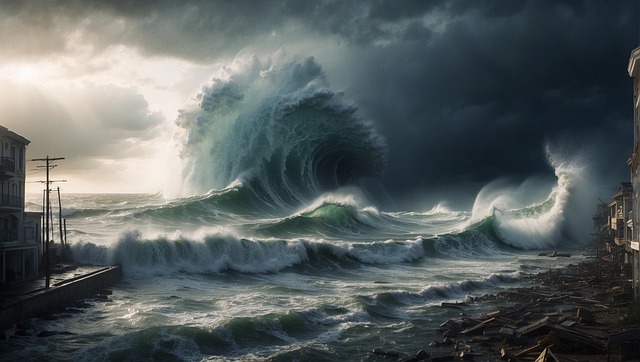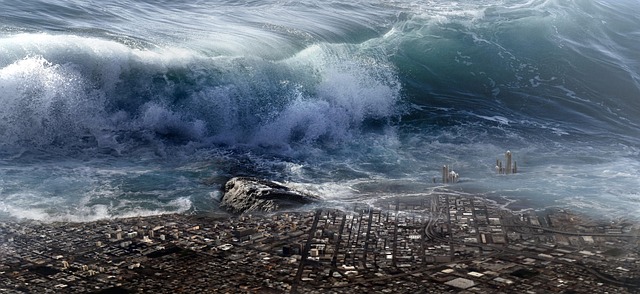When the earth shakes beneath your feet or the sea suddenly retreats from the shore, these are often ominous signs of an impending tsunami. Tsunamis are among nature’s most destructive forces, capable of obliterating coastlines in minutes. If you’re ever issued a tsunami warning, what you do in those crucial moments could be the difference between life and death.
Understanding a Tsunami Warning: What It Means
A tsunami warning is issued when there is a significant threat of a tsunami hitting coastal areas. These warnings are typically released by national meteorological agencies, such as the National Weather Service in the United States, the Japan Meteorological Agency, or the UK Met Office in coordination with global tsunami warning centers.
Types of Alerts You Might See:
-
Tsunami Watch: A potential for a tsunami exists. Be alert and prepared to act.
-
Tsunami Advisory: Minor tsunamis are expected. Stay out of the water and away from the shore.
-
Tsunami Warning: A tsunami with the potential for widespread flooding and damage is imminent or occurring. Take immediate action.
What to Do Before a Tsunami Warning: Tsunami Preparedness
Tsunami preparedness is crucial, especially for people living in or visiting tsunami danger zones near the coast. Here’s how to get ready:
1. Know Your Risk
Check whether your home, hotel, or workplace is in a tsunami hazard zone. Use local tsunami maps or government planning tools to understand your risk level.
2. Learn the Natural Warning Signs
-
A powerful earthquake lasting more than 20 seconds
-
Sudden sea retreat, exposing the sea floor
-
Unusual ocean behaviour, like frothy waves or walls of water
If you notice any of these, act as if a tsunami is coming — even if no warning has been issued yet.
3. Identify Your Evacuation Route
Every tsunami-prone region should have a tsunami evacuation route. Familiarise yourself with this route and practise walking it with your family.
4. Create a Tsunami Emergency Plan
-
Assign roles (e.g., who grabs the emergency kit, who helps small children or elderly)
-
Identify high ground (at least 100 feet above sea level or 2 miles inland)
-
Have a meetup point if family members get separated
5. Prepare a “Go Bag”
Your emergency tsunami survival kit should include:
-
Water and non-perishable food (3-day supply)
-
First aid kit
-
Flashlight and extra batteries
-
Copies of essential documents
-
Whistle, mask, hand sanitiser
-
Radio (battery-powered or crank)
-
Spare clothes and blankets
6. Stay Informed
Sign up for local tsunami alerts and warnings via:
-
SMS or email services
-
Emergency apps (e.g., NOAA, Met Office, TsunamiZone)
-
Local sirens and PA systems
What to Do During a Tsunami Warning
1. Evacuate Immediately
Do not wait for further alerts or confirmation. As soon as a tsunami warning is issued, move to higher ground or as far inland as possible. Every second counts.
2. Avoid Coastal Areas
Stay away from beaches, harbours, rivers, and low-lying coastal areas. Tsunamis can surge far inland and flow up riverbeds.
3. Use the Evacuation Route
Follow marked tsunami evacuation routes. If none exist, head uphill or at least 2 miles inland by foot if possible — road congestion could delay your escape.
4. Don’t Wait to Pack
Grab your emergency bag and leave. Do not attempt to gather extra belongings or wait for others if it compromises your safety.
5. Stay Away from Windows and Glass
If you are unable to evacuate and are in a multi-storey building, move to the top floor or roof. Avoid basements.
6. Stay Tuned to Alerts
Keep listening to emergency broadcasts via your radio, phone, or emergency services.
How to Survive a Tsunami: Practical Tsunami Safety Tips
-
Go on Foot If You Can: Roads will be gridlocked, and tsunamis can follow quickly after a quake. Walking or running may be faster than driving.
-
Stay Calm, Act Quickly: Panic wastes time. Follow your emergency plan and focus on getting to safety.
-
Be Ready for Multiple Waves: The first wave is often not the biggest. Tsunamis can come in a series of surges spread over hours.
-
Help Others If It’s Safe: If someone nearby is struggling or unaware of the danger, assist if it doesn’t put you in jeopardy.
-
Don’t Go to the Coast to Watch: Never try to view the tsunami. Tsunamis travel faster than you can run and often surge with very little warning.
What to Do After a Tsunami Warning
When the waves stop and the water appears calm, many assume the danger has passed — but this can be misleading.
1. Stay in the Safe Zone
Do not return to the coast until authorities declare the area safe. More waves may follow, and coastal infrastructure could be damaged or flooded.
2. Monitor Emergency Channels
Continue to monitor alerts from local officials. They will inform you of the all-clear and advise on when it’s safe to return home.
3. Avoid Flooded Areas
Floodwater can conceal debris, downed power lines, and sharp objects. Water may also be contaminated.
4. Help with Search and Rescue (If Trained)
Trained individuals may assist emergency responders in locating survivors or providing first aid.
5. Contact Family
Let relatives and emergency contacts know you’re safe. Use text messages or social media to reduce network strain.
6. Inspect Your Home (If Safe)
If your property is safe to access, check for:
-
Structural damage
-
Gas leaks
-
Electrical hazards
-
Water contamination
Do not turn on utilities until cleared by professionals.
Key Takeaways for Surviving a Tsunami
| Step | Action |
|---|---|
| 1. Prepare in Advance | Know your evacuation route and keep a go-bag |
| 2. Recognise Natural Warnings | Earthquake, sea withdrawal, unusual waves |
| 3. Evacuate Immediately | Don’t wait for official warnings in coastal areas |
| 4. Stay Informed | Use official apps and radio updates |
| 5. Wait for the All-Clear | Return only when advised it’s safe |
Common Myths About Tsunamis – Debunked
❌ Myth: “Tsunamis only happen in the Pacific.”
Truth: While the Pacific Ocean has more frequent tsunami activity, tsunamis can strike any ocean basin, including the Atlantic, Indian Ocean, and coastal Europe.
❌ Myth: “I’ll have plenty of warning.”
Truth: Sometimes, there’s no time for a warning. A tsunami triggered by a nearby earthquake can arrive in minutes.
❌ Myth: “Tsunamis are just big waves.”
Truth: Tsunamis are walls of water that can travel at jet speed and penetrate deep inland. They are more like surges than surfing waves.
Real-Life Tsunami Disasters: Lessons from History
-
2004 Indian Ocean Tsunami: Over 230,000 people died. Many ignored natural signs like the receding sea.
-
2011 Japan Tsunami: Nearly 20,000 killed. Despite advanced warning systems, many failed to evacuate in time.
-
1960 Chile Tsunami: The most powerful earthquake ever recorded triggered a tsunami that travelled across the Pacific and killed people as far as Hawaii and Japan.
These disasters underline the critical importance of early action and education.
Tsunami Safety for Travellers
If you’re holidaying in a tsunami-prone country such as Indonesia, Thailand, Japan, or Chile:
-
Choose hotels located away from the coast or on elevated land.
-
Know the local warning signals and sirens.
-
Ask hotel staff about tsunami evacuation procedures.
-
Always keep copies of your passport, insurance, and key items in your emergency bag.
Long-Term Tsunami Preparedness for Communities
Governments and local councils play a vital role in natural disaster preparedness, including:
-
Building and maintaining tsunami sirens
-
Creating public awareness campaigns
-
Constructing sea walls and buffer zones
-
Running drills in schools and workplaces
-
Maintaining clear tsunami evacuation routes
Final Thoughts: Be Ready, Not Scared
A tsunami warning is not just a suggestion — it’s a life-saving alert that demands immediate action. Whether you live by the sea or are visiting a coastal destination, having a plan can save your life. Equip yourself with knowledge, prepare your family, and respond swiftly if danger arises.
Because in the face of a tsunami, your best defence is preparedness.
Frequently Asked Questions (FAQs)
How much warning do you get before a tsunami?
It depends. Tsunamis caused by nearby earthquakes can strike within minutes, while those from distant seismic events may give you several hours of notice.
What’s the safest place during a tsunami?
The safest location is high ground or inland — ideally at least 100 feet above sea level or 2 miles from the coast.
Can animals sense tsunamis?
Yes, some animals can sense changes in the Earth and may flee to safety before a tsunami hits. However, humans should rely on technology and official guidance.
Should I evacuate if the sea pulls back?
Absolutely. A sudden sea retreat is one of the most reliable natural tsunami warning signs. Evacuate immediately.
Conclusion
Being issued a tsunami warning is a serious event that requires immediate and informed action. Your response can mean the difference between survival and tragedy. Use this guide to ensure you’re ready for the worst — and hopeful for the best.
If you live in or visit a tsunami-prone area, stay alert, be informed, and always have a plan.

